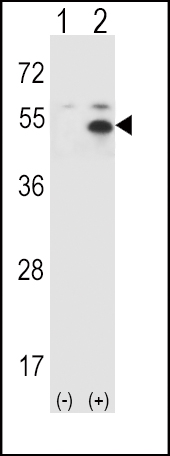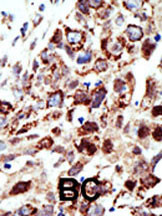


| WB | 咨询技术 | Human,Mouse,Rat |
| IF | 咨询技术 | Human,Mouse,Rat |
| IHC | 1/100-1/500 | Human,Mouse,Rat |
| ICC | 技术咨询 | Human,Mouse,Rat |
| FCM | 咨询技术 | Human,Mouse,Rat |
| Elisa | 咨询技术 | Human,Mouse,Rat |
| Aliases | Signal transducing adapter molecule 1, STAM-1, STAM, STAM1 |
| Entrez GeneID | 8027 |
| WB Predicted band size | 59.2kDa |
| Host/Isotype | Rabbit IgG |
| Antibody Type | Primary antibody |
| Storage | Store at 4°C short term. Aliquot and store at -20°C long term. Avoid freeze/thaw cycles. |
| Species Reactivity | Human |
| Immunogen | This STAM antibody is generated from rabbits immunized with a KLH conjugated synthetic peptide between 326-356 amino acids from the C-terminal region of human STAM. |
| Formulation | Purified antibody in PBS with 0.05% sodium azide. |
+ +
以下是关于STAM抗体的参考文献示例(注:部分文献信息为示例性概括,实际引用时需核对原文):
---
1. **文献名称**:*STAM and Hrs form a complex that regulates the sorting of ubiquitinated proteins into endosomal trafficking pathways*
**作者**:Komada M, Kitamura N
**摘要**:该研究阐明了STAM蛋白与Hrs(Hepatocyte growth factor-regulated tyrosine kinase substrate)在早期内体上的相互作用,揭示了二者通过泛素结合域协同调控受体酪氨酸激酶(如EGFR)的泛素化依赖性内吞及溶酶体降解过程,并利用STAM抗体验证了复合物的形成。
2. **文献名称**:*Involvement of STAM in the IL-2-mediated signaling pathway through its association with JAK3*
**作者**:Takeshita T, et al.
**摘要**:研究发现STAM通过JAK3激酶参与IL-2受体信号转导,STAM抗体免疫沉淀实验证实其与JAK3的磷酸化依赖结合,并表明STAM缺失会抑制STAT5激活,影响T细胞增殖和免疫应答。
3. **文献名称**:*Structural basis for ubiquitin recognition by the STAM-AMSH complex in endosomal sorting*
**作者**:McCullough J, et al.
**摘要**:通过晶体结构分析,揭示了STAM与去泛素化酶AMSH的复合物如何特异性识别K63连接的多聚泛素链,研究使用STAM抗体阻断实验证明该相互作用对内体分选及受体降解的关键作用。
4. **文献名称**:*Targeted disruption of the STAM2 gene in mice reveals its role in cell growth regulation*
**作者**:Mizuno E, et al.
**摘要**:通过构建STAM2基因敲除小鼠,结合STAM2抗体检测蛋白表达缺失,发现STAM2缺陷导致细胞周期阻滞和生长迟缓,提示其在生长因子信号传导中的必要功能。
---
**注**:以上文献信息为领域内典型研究方向示例,实际引用时建议通过PubMed或Google Scholar检索具体文献(关键词:STAM antibody, STAM signaling, endosomal sorting)。
**Background of STAM Antibodies**
STAM (Signal Transducing Adaptor Molecule) proteins, including STAM1 and STAM2. are cytoplasmic adaptors involved in signal transduction and intracellular trafficking. Initially identified as regulators of growth factor and cytokine signaling, they interact with components of the ESCRT (Endosomal Sorting Complex Required for Transport) machinery, particularly in endosomal sorting of ubiquitinated receptors for lysosomal degradation. STAM proteins also modulate Jak-STAT pathways by binding to activated cytokine receptors, influencing immune responses, cell proliferation, and differentiation.
STAM antibodies are essential tools for studying these processes. They enable detection and localization of STAM isoforms in various experimental models, aiding research into their roles in cancer, immune disorders, and neurodegenerative diseases. For instance, altered STAM expression has been linked to dysregulated receptor turnover (e.g., EGFR) and aberrant signaling in tumors. Antibodies targeting specific STAM domains or phosphorylation sites (e.g., Tyr residues) further help dissect post-translational modifications critical for their function.
Commercial STAM antibodies are validated for applications like Western blotting, immunoprecipitation, and immunofluorescence. Their development underscores the importance of STAM proteins in cellular homeostasis and disease mechanisms, driving ongoing exploration of their therapeutic potential.
×